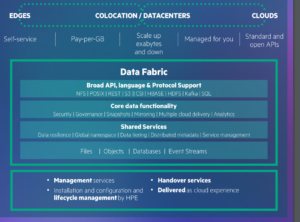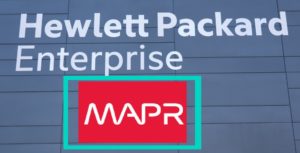
HPE Relaunches MapR Tech as Data Fabric Offering

HPE today unveiled GreenLake for Data Fabric, a new hybrid cloud data management solution designed to reduce challenges associated with data silos. The new offering, which piggybacks with a new private cloud solution HPE unveiled at its annual Discover conference, is based on technology HPE obtained with its 2019 acquisition of MapR.
While the rise of the public cloud has opened up a range of data storage and computing services for customers, it also exacerbates the data silo problem for certain types of customers that can’t utilize the public cloud for some of their data, says Vishal Lall, senior vice president and general manager of HPE GreenLake cloud services.
“What we have seen with our customers and what we’re hearing for them as well is, as they have adopted cloud, they have created one more problem, which is they have created more silos for data now,” Lall said during a press conference last week. “So some data resides in AWS, some data resides in [Microsoft] Azure, some data resides in their premises. So again they’re not getting the optimal business value from their data across multiple silos.”
HPE is addressing the dilemma with several new solutions unveiled at its Discover conference, which is taking place this week in Las Vegas, Nevada. One of those is a new HPE GreenLake for Private Cloud Enterprise, which gives customers access to the full gamut of 70 GreenLake compute and storage services form the comfort of their own data center or co-location facility (see related story “HPE’s GreenLake Cloud Service Goes Private”).

HPE has launched a data fabric solution based on technology it obtained with its MapR acquisition (Image courtesy HPE)
Another key announcement is HPE GreenLake for Data Fabric, which the company says addresses the data silo dilemma by giving customers a single control plane through which to manage all of their data, no matter if it runs in one or more public cloud, in the customers’ data centers, in co-location facilities, on the edge, or anywhere in between.
HPE GreenLake for Data Fabric is a hybrid data fabric, Lall said. “It enables hybrid data management as well as analytics for customers who have data in cloud, on premises, in data centers. We are enabling them to get business value from that data by being able to look at their data in a unified fashion versus looking at it silos that typically they see today.”
One of the key use cases for the data fabric is enabling customers to run analytics and AI/ML workloads across the data, “wherever it resides, which is a huge use case and business value,” Lall said.
The new data fabric offering is built on technology previously developed by MapR Technologies, the former Hadoop distributor that HPE acquired in a fire sale in 2019 when the startup’s financial backers suddenly pulled funding following a period of poor sales (a reckoning that hit MapR’s competitor, Cloudera, as well).
While the demise of Hadoop as a data platform occurred steadily and then all of a sudden in mid-2019, many technological components of the platform have continued to live productive lives, including open source projects like Apache Spark and Apache Hive and data formats like Parquet, etc. MapR did things a little bit differently, and its big (and proprietary) innovation was combining various storage mechanisms–including HDFS, NFS, an object store, a NoSQL database, and a streaming data system–into a single entity that can be accessed from a single global namespace, thereby helping to rein in disparate storage mechanisms.
That MapR innovation was previously sold as Ezmeral, and it now forms the basis of HPE’s GreenLake for Data Fabric offering. It’s all about taking a data-centric approach to data management, according to Flynn Maloy, HPE’s vice president of HPE Green Lake cloud services.
“Why can’t you move it to the public cloud? So much of that really goes back to the data wants to be here,” Maloy said during the press conference. “It’s being created at the edge, it’s very private, it’s very large. There’s lot of reasons why this is a very important part of a multi-cloud strategy. And as we’ve learned for our customers, it starts with the data.”
For example, a single MRI image is 30 gigabytes and its very private, he said. Healthcare companies are loathe to move large and sensitive data like this to the public cloud, and companies in other regulated industries, like financial services, face similar issues. With the new private cloud and data fabric GreenLake offerings, HPE is giving those customers the ability to keep their data on-prem while still giving them the advantages of cloud compute and storage.
Centralized data management and data access via open standards and APIs—including S3, POSIX, REST, SQL, Kafka, NFS, and HDFS–are the key deliverables with the new data fabric. according to Maloy.
“Being able to put a single global name space across all of those data silos all of those types of storage [like] files, object, databases, streams–putting that with a data fabric that you can bring in your analytics…different languages and protocols to run the analytics you need to get the insight you need—this is a very important and much asked for offering from us and it marries perfectly with…the private cloud,” he said.
In addition to data access, the data fabric provides governance and security capabilities. Customers will get data resiliency features like data tiering, snapshots, and mirroring. Customers will be able to scale the solution up and down as needed, and HPE will bill for GreenLake for Data Fabric on a per-gigabyte basis.
“GreenLake is the cloud that comes to you,” Maloy said. “This is the innovation that HPE has brought to the market. We believe that GreenLake is a very important part of a multi-cloud strategy.”
Related Items:
HPE’s GreenLake Cloud Service Goes Private
HPE Adds Lakehouse to GreenLake, Targets Databricks






























